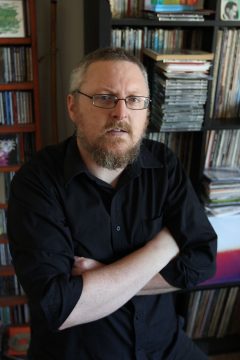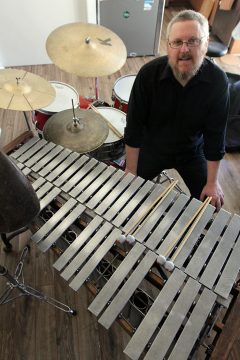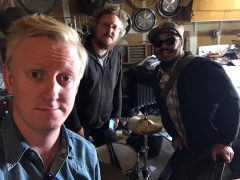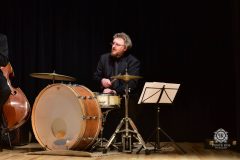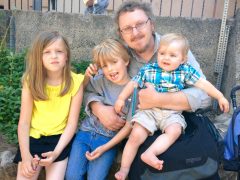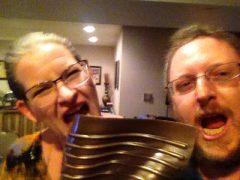Cover Story
Nathan Hubbard: Still Furiously Dreaming
The improvised music we call jazz is full of workaholics and overachievers—it tends to go with the territory. I’ve met dozens of hard working musicians over the years with superhuman ambitions and the stamina to achieve them.
Having said that, I could easily make a case for drummer/bandleader/composer/instrument builder Nathan Hubbard as a special case. Keeping up with Hubbard’s wildly ambitious schedule is no mean feat.
Nathan has released no fewer than 35 albums as a leader or co-leader since he began putting out records in 1999 with the band Return to One.
After three albums with that group, Hubbard released every kind of imaginable project—from solo recordings to a wide variety of distinct bands like the massive Skeleton Key Orchestra and the collection of almost 50 musicians that comprised the five-disc release, Encinitas and Everything After, which earned Hubbard his first win for Best Jazz Album at the San Diego Music Awards in 2015.
He has also put out albums by the Arizona-based group the Scorpion Decides and the beat-oriented Ogd_S(11) Translation Has Failed. He won a second San Diego Music Award in the Best Jazz Album category, in 2017, for the enticing free-jazz orchestra effort Furiously Dreaming, which is quite an achievement given the uncompromising nature of the work.
Hubbard has perhaps the most open attitude about music that I have ever encountered. He’s as passionate about Led Zeppelin as he is about Cecil Taylor, and he’s got endless enthusiasm for everything from John Cage to Public Enemy.
In fact, Hubbard is a true connoisseur of hip hop, something he has demonstrated recently with the co-op band Parker Meridien featuring emcee Parker Edison, bassist John Rieder, and cellist Sharon Taylor, alongside Hubbard’s drums and samples. That band won Best Hip Hop at last year’s SDMA ceremony.
Hubbard also plays orchestral percussion. He was trained in that genre by mentors like Pat Pfiffner at Palomar College and Danlee Mitchell at San Diego State. Most often it’s vibraphone and marimba, with occasionally tympani. All of these skills come in handy when Hubbard works in musical theater around town, a pursuit he engages in several times a year, often for weeks at a time.
He also plays vibes often as a leader in the improvised music vein, and I can attest that he’s a serious mallet man.
I first encountered Hubbard some nine years ago as a member of the volcanic free-jazz cooperative group Cosmologic, featuring tenor saxophone giant Jason Robinson, trombone virtuoso Michael Dessen, and the redoubtable bassist Scott Walton.
Cosmologic was a terrific ensemble, quite unlike anything I can remember in San Diego jazz history. They originally began as a kind of repertory band playing the music of jazz maverick Ornette Coleman, but they soon evolved into a blistering ensemble featuring original compositions from everyone in the group.
I got the opportunity to witness Cosmologic live several times before they were all pulled in different directions (Robinson moved to Amherst; Dessen became a professor at UC Irvine, and, the last I heard, Walton moved to France after teaching for several years in the Bay Area.)
Nathan is a true original. He’s one of the most creative and productive artists I’ve collaborated with, constantly exploring new ideas and sounds. His music is deeply connected to place and especially to San Diego, and he has built up a vast body of works that integrate all kinds of genres and sounds in unique ways. This takes real skills and study, not just a desire to do something experimental, and Nathan has the chops to pull it all off (as well as to play more traditional gigs). He’s also been an important creative mentor for tons of younger musicians in the area, folding them into large and small projects, and offering them a model of what it means to find your own artistic path.
—Michael Dessen, trombone
These guys represented the compositional side of the free-jazz continuum with style, power and grace, and I was blown away by Hubbard’s approach to the drum set. He seemed to embody the ethos of pioneers like Paul Motian on one end of the spectrum to former Albert Ayler/Cecil Taylor sideman Sunny Murray on the other. Playing in waves rather than specified beats—Hubbard was all over the drums, scraping the edge of a cymbal with violin bow at one moment then dropping pieces of random hardware on a tom-tom the next. In between there was a constant barrage of homemade instruments and percussion oddities that kept a stream of communication open.
I had never seen anything like that happening in San Diego. Nathan Hubbard might just be the most versatile drummer I’ve ever seen. I don’t know of anyone else who can pull off a reasonable approximation of Keith Moon (which Hubbard managed for a recent production of Tommy by The Who), then turn around and engage with multi-woodwind virtuoso Vinny Golia in a spontaneously improvised set, then drop big beats to propel the rapping of Parker Edison.
And that’s just the tip of the iceberg for Nathan Hubbard. He’s a relentless composer, who just released two brand-new sessions. The first is a kaleidoscopic trio with Golia and bassist Steuart Liebig recorded live in Ensenada, Mexico, called Next Outpost. The second is a recording with his long-standing jazz trio featuring Kevin Jones on guitar and Harley Magsino on bass called This Stream.
I’d call him a polymath. But I’m not sure that term does him justice. I almost forgot to mention that he’s a devoted husband to wife Kelly and father to three kids: Julia (13), Elliott (10), and Henry (5).
The Hubbard interview
My first question to Nathan had to do with trying to nail down his first memories of hearing music—because I always find the answer to that question to be revealing.
“I think it was the usual FM radio in the car,” he answered. “But my mother also had a collection of ’70s rock albums like Led Zeppelin II and Neil Young’s Harvest, and Joni Mitchell’s Ladies of the Canyon. My older brother was really into what they call ‘hair-metal’ now. I remember hearing all that stuff on the radio and trying to sing along with it in the back of the car, or riding my bike and humming songs to myself.”
I wondered if music had always been his creative mission.
“I was interested in music from the very beginning. I have old notebooks from those days of me writing lyrics and trying to write rhythms long before I had any idea of how to use traditional notation.”
So were the drums your first instrument?
“I started playing the drums in the fifth grade concert band. Then when I got to junior high school, there was an after-school jazz band that played tunes like “Killer Joe” and stuff like that. I talked my father into buying me a used set of drums and I started playing things like Black Sabbath and the usual garage band stuff with other kids my age. In high school I played in the marching band and started playing in a jazz ensemble at night school, taught by Eric Keeling, who was a teacher in North County. Through him I met Roger Riedlbauer, and we started rehearsing. Then Eric got us a gig at the Miracles Café in Cardiff and they asked us to come back in the summer so we started playing there every week.”
The Family Business and Early Drum Heroes
Anyone who has spent time in the construction business is familiar with the Hubbard name. They’ve run a successful contracting business for years. I was curious to ask if Nathan ever entertained any notion of joining Hubbard Construction.
“I grew up in Encinitas and I grew up around big heavy equipment. I got to be pretty handy around a drill press and an angle-grinder and a lathe and other tools. When you’re a drummer, you’re always modifying things—so I was always learning how to make things. I took a wood shop class in high school and all of those skills came together later when I started making instruments. So even though I had no desire to join the family construction business, I still really enjoy working with my hands.”
So who did you want to be, drum-wise, in those early years?
‘The first drummer that I really noticed was John Bonham on Led Zeppelin II, mostly for that distinctive ride cymbal sound. A friend of my father found out that I was interested in jazz, and he gave me Max Roach’s As Quiet as It’s Kept and Dave Brubeck’s Gone With the Wind, and Red Garland’s Traneing In. All of that stuff totally blew my mind, and Max Roach especially was a huge influence; the way he played with brushes and mallets, wrote his own tunes, and led his own bands was very inspirational to me.”
Were your musical tastes always so broad?
“I think so. In the ’90s when they had these record clubs like Columbia House, the first two CDs I ordered were a Charlie Parker compilation and a disc by the Art Ensemble of Chicago [laughing]. I didn’t realize how the different eras were viewed, I always thought of it as one glorious history line.”
The meaning of the word “jazz” and other instruments
So what do you think about the word jazz? Does that have any meaning for you?
“There are so many definitions that I prefer not to use the word—but in my own personal language, I look at jazz as a kind of matrix for how to approach music. Clearly there are historic aspects like the music of Louis Armstrong, Charlie Parker, and Ornette Coleman, to name a few, but mostly, I find that the term kind of puts you in a box. If someone has never heard my music, jazz is a convenient term, but generally I find that labels and genres can be limiting and not very useful.”
We talked about your early drum influences. How about now… can you name your top five drummers or at least try to narrow it down?
“That’s a really hard question. I still think John Bonham and Max Roach are keystones. The older I get, the more I appreciate Tony Williams—his composing, drumming, and bandleading. I love Airto, the colors and grooves he’s into. Clyde Stubblefield [James Brown] is another one. That’s already five and I haven’t even scratched the surface. I mean Gerry Hemingway has been a huge influence. Paul Lytton and Sunny Murray are all big inspirations for me. Elvin Jones. Cevin Key. Ronald Shannon Jackson. I love strong drummers with unique voices.”
What led you into playing mallets; how did that evolve?
“I was just trying to understand music from a larger perspective. I was taking piano lessons in high school, and I was playing glockenspiel in the marching band. When I got to college, I wasn’t exactly sure what I wanted to do so I ended up as a classical percussion major. I studied with Pat Pfiffner at Palomar College—he completely kicked my butt. He sat me down and explained everything I needed to be practicing if I wanted to get to the next level. So most of my schooling has been as a classical percussionist. From there I transferred to San Diego State where I studied with Danlee Mitchell and I mostly played classical marimba. But I was also in the jazz department and I would do drum set gigs around town as well.”
What were your goals when you got to San Diego State?
“So, for me, it was just wanting to study with Rick Helzer and trying to understand harmony and things like that and to just continue to develop. I think the writing has always been the leading thing—clearly the drums are very important—but drums usually follow where the writing is going.”
One of the things you do as a working musician is musical theater. Can we talk about that for a minute?
“I’ve always been the kind of musician that just wanted to get better. Any gig I could get, I would take. So people started calling me for these shows. I’m usually playing the ‘Percussion 2’ book, which is usually mallet and timpani. I’ve learned a lot about pacing from doing these shows, especially when you do 40 shows in a row. It’s a really interesting way to just dig into real microscopic technical issues and it has allowed me to focus on the minutia.”
What did you learn at San Diego State that stays with you to this day?
“Danlee Mitchell told me that I need to practice harder or he’d never admit to being my teacher. I learned to put the time in and really do the work. San Diego State was where I met most of the people that I collaborated with for the next ten years and even to this day. I learned how to deal with politics in both good and bad ways. I learned how to write for medium size and large ensembles.”
I have known Nathan a long time now, in fact we just finished a trio tour, which included the great electric bassist Steuart Liebig. Nathan has always been a forward thinking individual, very rooted in the DYI aesthetic, which I love. His playing is sensitive and grooves nicely in many ways. On the road he is a considerate and thoughtful human, very omnivorous in his musical tastes, and has amazing insight on a wide variety of subjects when we are in conversation. I like playing music with him quite a bit I and I enjoy being with him as a person—he knows where all the best taco places are everywhere!!
—Vinny Golia, woodwinds
Milestone Ensembles
So lets talk about some important early bands, starting with one you started when you were still in high school, I believe, Return to One.
“I met Roger Riedlbauer in a night school class and then through that we got this gig at Miracles Café, which sort of turned into the band Return to One. Eventually, people left for college so I added Lee Elderton on saxophone and Josh Jones on bass. We had a lot of different influences like the Elvin Jones Trio and Ornette Coleman’s quartet. At some point we stopped playing standards and concentrated on original music. We ended up adding Ward Baxter on saxophone and bass clarinet, and we made three records.”
To me Cosmologic was one of the premier groups in San Diego at the time. Can you run down how that came about?
“We started out as a kind of Ornette Coleman repertory band. The group was Jason Robinson on tenor saxophone, Michael Dessen on trombone, Scott Walton on bass, and myself on drums. We started doing some gigs and writing tunes and things just developed from there. The fact that it was a collectively organized band was interesting—the kind of decisions that people were willing to fight for. It was a fantastic learning experience and we made a lot of great music together.”
Let’s talk for a minute about the ARC Trio with Justin Grinnell on bass and Rick Helzer on piano.
“As Return to One was winding down, I was talking to Justin about different ideas and the notion of playing with Rick Helzer seemed like a really good thing at that point. We asked him and he was totally into it. We started throwing tunes at each other and it was a great experience. Rick was into playing tunes but also into deep improvising, so a lot of the rehearsals for that band were half working on really difficult notation and the other half playing completely free improvisation. It was a really interesting dichotomy.”
Now, let’s talk about the huge ensemble Skeleton Key Orchestra. What brought that on?
“I was playing in Cosmologic and Return to One at the same time, and these guys had never played together, so I thought it would be great to combine both bands together. That was the start of Skeleton Key. We played our first gig on Jazz Live [Jazz 88.3 KSDS] and did a bunch of gigs, and we have two albums out. It’s really sort of the furthest I’ve gone with writing. You have 16 different voices, two bass players, two drummers, multiple guitarists, singers, a DJ, and poets, so there are so many possibilities.”
Who were the role models, compositionally for your Skeleton Key writing process? Was Anthony Braxton an inspiration?
“Yes, I love Anthony Braxton’s music! For SKO there is the looming shadow of the big band tradition. I mean, I’m a huge fan of Duke Ellington especially the suites like Black, Brown and Beige and the New Orleans Suite. Clearly, there is the influence of Cecil Taylor’s large ensemble writing, and I love Kenny Wheeler’s work for large ensemble. Barry Guy, Vinny Golia, and Mike Mantler also had a huge influence on my writing.”
Nathan Hubbard covers a wide range of interests, from inventing percussion elements to chili peppers, from cosmologic to parking structures. he is perhaps at his most persuasive regarding after gig burritos.
—Miff Mole (KSDS “Free Time)
I’ve always been amazed by your output and all of the energy that you put into these myriad projects. You’ve put out a ton of records, where does all this energy come from?
“In a larger sense I come from a family of workaholics. I always want to be doing something. I look at my output in three categories—solo records, medium sized groups and large ensembles. When I just had Return to One as a creative outlet—we tried everything—we did graphic scores and we did free improvisation and highly notated things. I realized I didn’t need to express everything in one group so I started setting up groups with specific ideas. Passengers was about rhythmic and harmonic ideas with very limited melodic information. The Scorpion Decides was set up to use concepts coming from electronic music and putting it into an open-ended jazz setting. Ogd_S(11) Translation Has Failed was set up to deal with rhythmic ideas in terms of popular music,”
You’ve had a long relationship with Vinny Golia, one of the most creative voices in modern music. What can you say about that relationship?
“Well I first heard Vinny in the late ’90s, I think on a Brad Dutz record. I have always loved his multi-woodwind mastery and the quality of his lines and how he puts things together. I’m first and foremost a fan, and then I got the opportunity to play with him, which is very challenging. I’ve gone out of my way to play with him. We released a duo CD in 2017 and now there is the trio with Steuart Liebig who is another person I view as a mentor and a friend.”
Okay, let’s talk for a minute about your hip hop group with Parker Edison on spoken word, John Rieder on bass, and Sharon Taylor on cello. The group is called Parker Meridien. How did that come about?
“A lot of people look at me as this avant/jazz experimental guy, which is understandable, [because of] what has been documented. But I think I have a long history of playing popular music. I toured a lot with Rafter Roberts, which was sort of in the dance/pop vein. I’ve played on a ton of folk and rock records. I’ve always made beats and written hooks and Parker Meridien is kind of the culmination of all of that.”
You guys won a Best Hip Hop award last year at the SDMA. That makes three wins. Does that feel like an affirmation for all of these years of hard work?
“Definitely. Everything I’ve been able to achieve has been through a lot of hard work and having people shut doors in my face. So, understandably, a lot of the music I make is not mainstream. It’s not for everybody, but I’ve never thought of it in those terms—I understand that it’s off most people’s radars. So when something like that happens… it’s kind of insane. I mean Encinitas And Everything After was a five-disc set about my hometown with close to 50 musicians on it. The Skeleton Key record Furiously Dreaming is very dense and uncompromising music. Winning Best Hip Hop for the Parker Meridien album The Twenty First Street Sessions felt like a dream. None of us expected that to happen,”
Nathan is a good dude. He creates as second nature. If music wasn’t a thing he’d be a scientist or an inventor. It’s just what he does.
—Jack King (a.k.a. Parker Edison)
Last question. How do you balance the life of a creative musician with being a father and husband?
“It works because we put in the work. I think any relationship requires a lot of work, and a marriage with three kids is definitely a lot of work. But that’s what I signed up for and I’m happy to be doing both. My wife, Kelly, is a huge support in every way. She’s definitely someone I can bounce things off of. She’s not a musician, so she has a different perspective. She’s got a civilian ear and she’s able to give me important advice from that perspective.”






